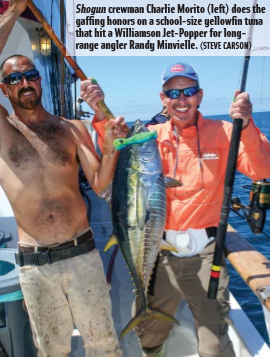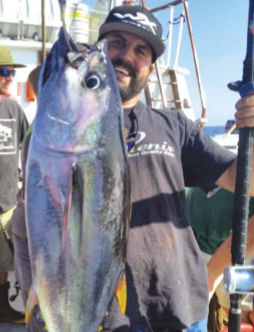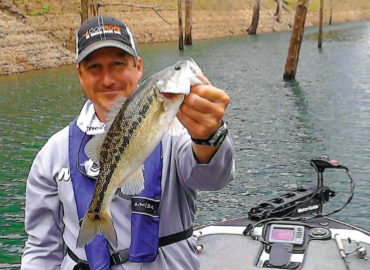THE RIGHT LINE
HITTING IT BIG ON THE LOWER SACRAMENTO RIVER IS ALL ABOUT MINDING YOUR LINES
By Jeff Lund
REDDING—
There are lines all around us. Some are written, drawn and paved; others form, whether at the DMV, the grocery store or for a beer and a hot dog at the ballpark. But the most important, by far, are fishing lines.
On a March 2014 trip to the lower Sacramento River, my buddy Chris Barnes and I booked a guide from The Fly Shop (800-669-3474; theflyshop.com) in Redding to ?oat us over some of the legendary rainbows that stalk these waters. It was my third trip through The Fly Shop and second with our guide, Shane Kohlbeck.
EARLY SUCCESS
We started just upriver from the Sundial Bridge, and on the first four drifts down a line, I had three fish and Chris had one. Chris has an extensive fishing résumé, including 8-foot sturgeon, hundreds of shad, stripers and largemouth bass. What he hadn’t done to that point was lock the butt section of a fly rod into his forearm and feel the thrashing of a ?sh down his ulna.
He didn’t say much as he fought his first fish on a fly rod; yet between the grunts, it was obvious the sensation was new and impactful.
“He’s ruined now. He’ll never be the same,” said Shane. I agreed. As

the current slowed to an imperceptible crawl Shane told us to strip in our rigs. He turned the boat and rowed back up to the top of the run. He swung into the slow, slack water where the smooth river rocks were made slick by a layer of orange organic material.
“We’ll be going left side. Chris, go ahead and start casting,” Shane directed us.
Shane had spent a good 20 minutes on a drift boat-fishing tutorial before we started. As a guide who is interested in getting his clients into fish, he felt the need to be thorough in his instruction about how to cast and, you know, do things that catch fish. So when Shane told Chris to start casting, the beginner knew what to do, and by the time we reached the top of the line, Chris was fishing.
I glanced downriver before I flopped my rig into the fray. I noticed another boat that had been fishing the same area. The craft started down a parallel line but probably 6 feet closer to shore than ours. I didn’t pay attention to how they did; I just noticed the difference in lines.
As instructed, I kept my unblinking eyes on the strike indicator – hoping it would stop, dip, bounce or dive. It did. My left hand pulled the slack fly line through eyes of the rod Shane and I pinned the now-tight line to the cork. Fish on. I stripped to keep the rod bent and felt the shake of the fish. It wasn’t big, but it was another rainbow in the net.
It was going to be a good day.
CONTROLLED CHAOS
Once we were convinced that particular fast-water edge had given up what it would, we continued our drift. The other guys went through the same section once more, then passed us and we didn’t see them again until the takeout.
In the meantime, Shane had lines all over the place, so we were consistently getting hit as we made our way down the 5-mile float. We didn’t get them all, because sometimes even when you’re ready for a strike, the spit happens faster than the set, but we were rather busy.
At the base of a shallow riffle, Shane dropped anchor. As a guy used to fishing from boats or fishing slow-moving water, this didn’t seem fishy to Chris. Rather than doubt, he just nodded his head and readied himself for instruction.
With weight on the rigs to get the nymphs down, it would appear that an angler would almost immediately get caught on the rocky 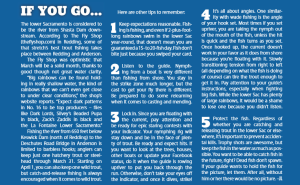 bottom, which was less than a foot deep. It was a spot that most guides – people, really – hardly mess with. There’s anchoring involved, some potentially tough rowing, and, of course, a real threat of snags. But Shane is concerned with trout, not excuses.
bottom, which was less than a foot deep. It was a spot that most guides – people, really – hardly mess with. There’s anchoring involved, some potentially tough rowing, and, of course, a real threat of snags. But Shane is concerned with trout, not excuses.
Shane told Chris to flop a cast into the whitewater, mend it quickly, give it line and get ready. What Shane saw in that shallow riffle wasn’t the shallow riffle, but the dropoff, which was evident by the change in the color of the water.
After a few fruitless drifts, Shane took the rod and was immediately into a fish. It was close to a foot long and provided the evidence Chris was looking for.
Chris executed the next cast perfectly and had his own. As the river deepens, the fast water continues on top, providing slow water for the fish to hold and wait for food to float by. The speed of the current also prevents snags and sinks the nymphs just enough that they’re prime for a take at the dropoff.
A ROOKIE GAINS CONFIDENCE
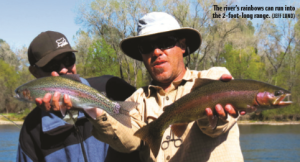
Chris had it now. He sent his next series of casts further and further from the boat, working all the feeding lanes. The indicator dove,
and as he looked down to get the line between his finger and the cork, the massive rainbow jumped. Shane and I shouted in unison.
Chris didn’t see as he tried to pin the line, but sure felt it. The rod tip continued to bounce spastically. It was probably the biggest fish of the day, a rainbow deep in belly and color thrashing away at the other end. As Shane extended the net to scoop, the nymph came free and the fish swam off.
I felt bad for Chris. He was ruined. The gape of his mouth told me that, though he’d been catching and losing fish for decades, this one would haunt his immediate future. His shoulder was sore from all the fishing, but in that moment he forgot about it and instead stood with the pain of losing a sick fish.
Sometimes great days have their flaw. We landed a few more – including a double – then reeled up for the last quarter of a mile. We’d been on the water for hours and the sun had taken its toll, but we didn’t notice until we didn’t have an indicator at which to stare. We’d been so focused on lines and ?sh that we’d even forgotten trivial things like hunger.
A GREAT DAY
When we arrived at the takeout, we saw the dudes with whom we’d shared similar but not exact lines to start the day.
They asked how we had done as the rower retrieved the truck and Shane got his vehicle.
There was a temptation to shout our number because we’d had a great day, but they seemed more urgent to find that someone else had endured a similar day.
“We did alright; a couple around 20.” The truth was a couple of the 20 we caught were 20 inches.
They mentioned it had been a tough day. The wind was bad. The bite was bad.
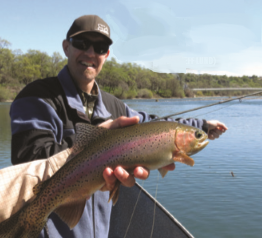
We hadn’t noticed. Shane’s lines were true.
When Shane and their rower, who it then occurred to me could have been a guide, exchanged notes, we discovered we were fishing similar rigs, but our lines and depths were different. That’s the difference between a 20-fish day and a two-fish day.
Shane drove us back to the launch where we left Chris’s truck.
We thanked him, shook hands and followed the drab, gray asphalt south. We had three hours ahead of us, but stories of good lines to keep us company. CS
Editor’s note: Jeff Lund formerly lived in Manteca and writes for our sister magazine, Alaska Sporting Journal.

